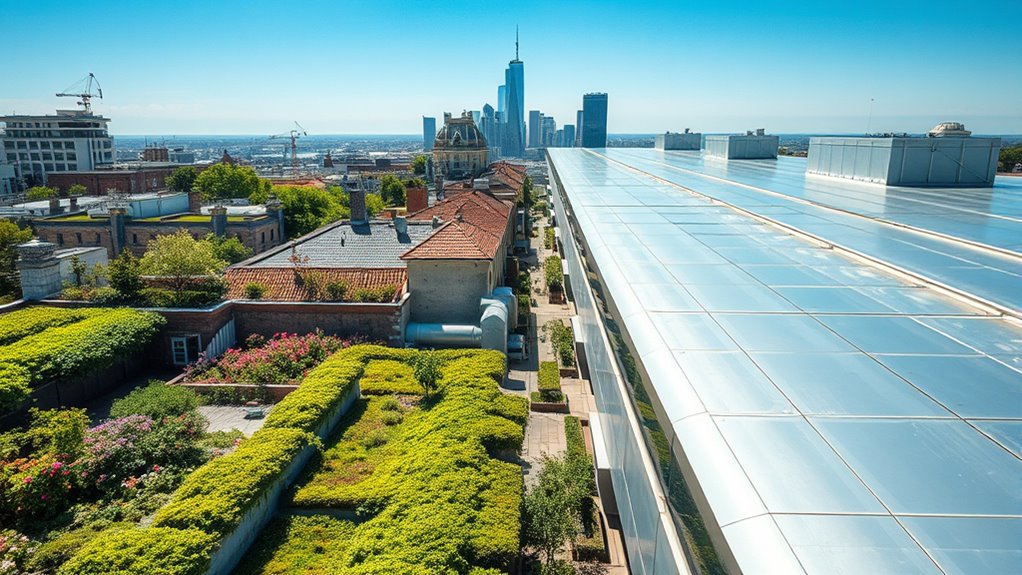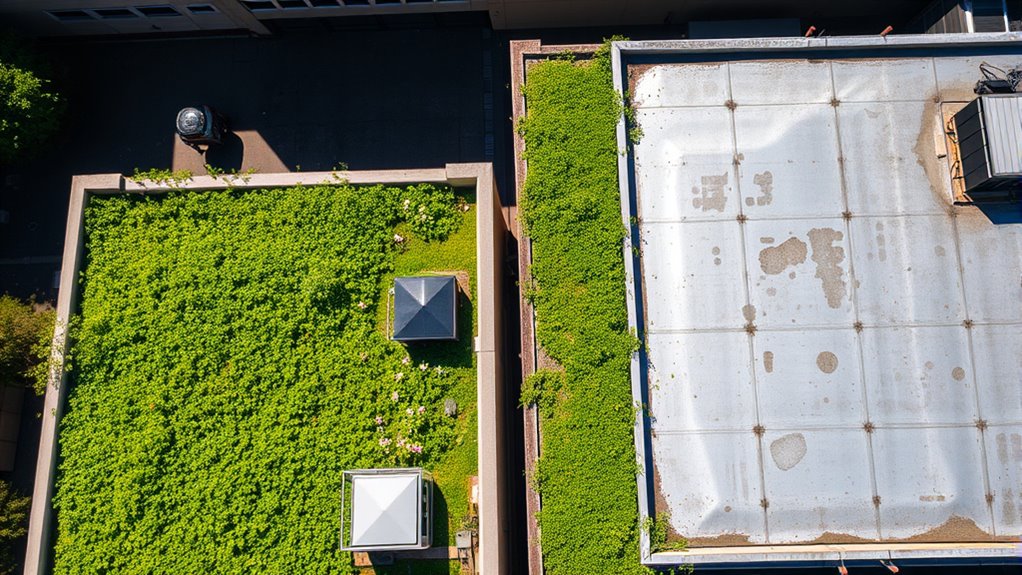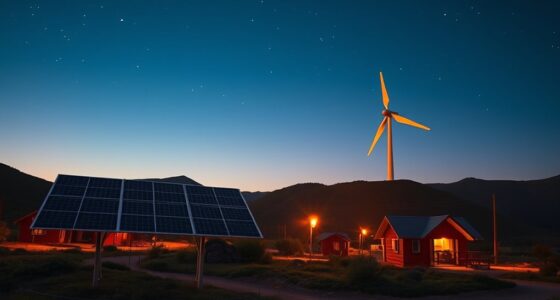Choosing between green roofs and cool roofs depends on your climate and goals. Green roofs absorb rainwater, provide natural cooling, and reduce urban heat islands, but they require more investment and maintenance. Cool roofs reflect sunlight and lower surface temperatures, making them easier and cheaper to install. If you want an eco-friendly option that manages stormwater, green roofs work better. To find out more about which could suit your needs best, keep exploring the details below.
Key Takeaways
- Green roofs provide stormwater management and natural cooling, while cool roofs mainly reflect sunlight to reduce heat absorption.
- Green roofs require higher upfront costs and maintenance; cool roofs are easier and less expensive to install and upkeep.
- Green roofs are more effective in managing rainwater and supporting biodiversity, whereas cool roofs excel at lowering urban heat islands.
- Climate influences effectiveness: green roofs work well in moderate climates; cool roofs are versatile across various conditions.
- The best choice depends on priorities like stormwater control, energy savings, climate, and maintenance capacity.

When choosing between green roofs and cool roofs, understanding their benefits and limitations is essential for making an informed decision. Both options aim to improve urban environments, but they do so in different ways. Green roofs, covered with vegetation, help manage stormwater runoff by absorbing rainwater and filtering pollutants. This reduces the burden on city drainage systems and minimizes the risk of flooding. Additionally, green roofs play a vital role in combating urban heat islands—areas in cities where heat is trapped due to dense concrete and asphalt. Vegetation on green roofs provides natural cooling through shade and evapotranspiration, lowering rooftop temperatures and, consequently, overall urban temperatures. This cooling effect enhances comfort, reduces energy consumption for air conditioning, and improves air quality by decreasing the formation of smog. The presence of greenery can also contribute to biodiversity in urban settings, supporting various species of birds and insects.
Green roofs reduce urban heat and manage stormwater through vegetation and natural cooling.
Cool roofs, on the other hand, are designed with reflective materials that bounce sunlight away from building surfaces. They are typically made of light-colored or specially coated materials that reflect more sunlight than standard roofs. By reflecting solar radiation, cool roofs markedly reduce the heat absorbed by buildings, which in turn decreases indoor cooling loads and energy costs. While they don’t directly manage stormwater, cool roofs contribute to mitigating urban heat islands by lowering surface temperatures in city centers. This reduction in heat can improve air quality, decrease the urban heat island effect, and make city environments more livable during hot months. Cool roofs are often easier and less costly to install and maintain compared to green roofs, making them an attractive option for many building owners. Furthermore, cool roofs can be integrated with other renewable energy solutions to maximize overall energy efficiency.
Both solutions can also be affected by climate conditions, which influence their effectiveness and suitability for specific locations. However, both solutions have their limitations. Green roofs require substantial initial investment, structural support, and ongoing maintenance, which can be challenging for some buildings. They also need a suitable climate and sufficient access to water for healthy vegetation. Conversely, cool roofs may not provide the same level of stormwater management benefits as green roofs, and their reflective surfaces can degrade over time, reducing effectiveness. Additionally, in colder climates, cool roofs might reflect heat during winter, potentially increasing heating costs.
Ultimately, the choice depends on your specific priorities and local conditions. If stormwater management and reducing urban heat islands are top concerns, green roofs offer considerable benefits. If lowering energy costs and quick installation are more important, cool roofs might be the better fit. Both options contribute positively to urban sustainability, but understanding their unique advantages and limitations helps you decide which aligns best with your goals. Considering urban heat island mitigation strategies can further enhance the overall effectiveness of these roofing options.
Frequently Asked Questions
How Do Green and Cool Roofs Compare in Cost Over Time?
You might wonder about the long-term costs of green and cool roofs. Green roofs often have higher installation costs and maintenance expenses due to plant care and structural support. Cool roofs typically cost less upfront and require minimal maintenance. Over time, cool roofs may save you money on energy bills, but green roofs can offer added benefits like insulation and stormwater management, balancing out the costs in the long run.
Are Green Roofs Suitable for All Building Types?
You might wonder if green roofs suit all building types. While they excel in adding urban canopy and promoting ecological benefits, they’re best suited for buildings with strong structural support and enough space for installation. Architectural integration is key, as some designs may not accommodate green roofs easily. For smaller or less sturdy structures, cool roofs could be a better choice, offering efficiency without extensive modifications.
Which Roof Type Has Better Long-Term Durability?
When considering long-term durability, you’ll find that cool roofs generally have greater roof longevity due to simpler maintenance requirements and fewer elements prone to wear. Green roofs, while environmentally beneficial, demand more ongoing upkeep and are more vulnerable to structural issues over time. If durability is your priority, opting for a cool roof means fewer repairs and longer-lasting performance, making it a more reliable choice for the long haul.
How Do Climate Conditions Affect Roof Performance?
Climate conditions considerably shape your roof’s performance. In urban heat, your roof fights increased temperatures, making cool roofs that reflect sunlight a smart solution. Heavy rainfall impacts your roof’s durability, especially for green roofs that absorb water, risking leaks and damage. You must consider these climatic quirks to choose a roof that resists rain, reduces urban heat, and endures weather’s whirlwinds, ensuring your roof remains reliable and resilient.
Can Both Roof Types Be Combined for Enhanced Benefits?
Yes, you can combine green and cool roofs for enhanced benefits. By integrating solar panels, you improve energy efficiency, and considering aesthetic aspects guarantees the design complements your building. This hybrid approach maximizes insulation, reduces heat island effects, and boosts sustainability. You’ll enjoy better climate control, lower energy costs, and a more attractive roof, all while promoting eco-friendly practices. Combining these options offers a versatile, effective solution tailored to your needs.
Conclusion
Ultimately, whether you choose a green roof or a cool roof, both options help you beat the heat and save energy. Think of green roofs as a lush, living blanket, while cool roofs act like a reflective shield. Each works differently, but both make your building more eco-friendly. Consider your climate, budget, and maintenance when deciding. Whichever you pick, you’re taking a smart step toward a greener, more sustainable future—like planting a seed for positive change.










